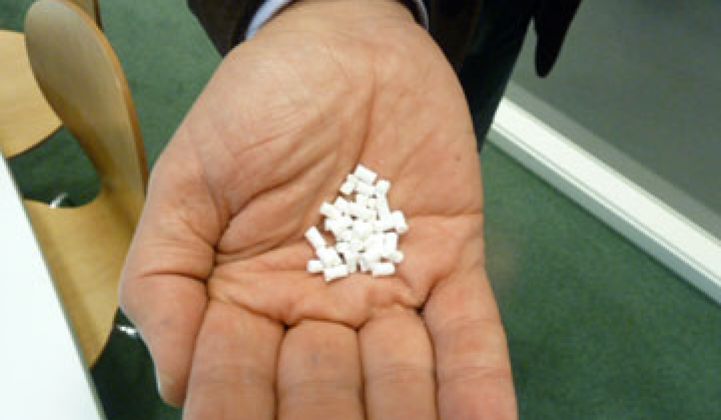STOCKHOLM --- Aerogel has been the world’s best form of insulation for nearly 100 years. The material, however, has only occupied niche markets because of its Rolls-Royce prices.
Even inexpensive aerogels -- which look like hunks of plastic but are actually complex, porous strands of silica that capture air or molecules -- start at approximately 50 to 80 euros ($70 to $112) and can sell for far more. The high cost comes largely because the raw materials get cooked in high temperature/high pressure environments in relatively small batches.
Svenska Aerogel (SA), one of the numerous companies in Sweden trying to break out of an incubator, has devised a process that can convert silica into aerogels at ambient temperatures at low pressures in a continuous (instead of a batch) fashion, according to CEO Anders Lundstrom.
“We’re talking a price reduction of about 90 percent,” he said.
Along with requiring less energy, the process also lets aerogels take different forms. Conventional aerogels look like pieces of nearly-clear plastic. SA can make aerogel pellets (see photo) or powders, which in turn opens up markets beyond insulation.
Aerogels, for instance, could be added to concrete to make it less susceptible to cracking. Some potential customers want to evaluate it for de-humidification and filtration: active particles are dispersed in an even array inside the gel. In one de-humidifying trial, the aerogel-enhanced equipment removed moisture from a room 50 percent faster than normal, boosting the output of the equipment by 33 percent.
Researchers at the company also believe spray-on aerogels will be possible: a thin coating could make fabrics or paint repel or absorb paint, depending on the desired effect. Another possibility: deploying them in fuel cells to disperse catalysts like platinum more evenly and efficiently on membranes.
“It is a network for capturing molecules,” he said. “A sugar cube-size amount of the material has the same surface area as tennis court. [...I]t keeps its functionality up to 600 degrees.”
If funds can be raised, the company hopes to graduate from sample manufacturing to commercial production next year.
What’s the secret? Lundstrom isn’t telling. The research began in 1997 as a way to improve filters. “Aerogels can capture material. It should be the best molecular filter in the world,” he said.
The company then got formed in 2000 and has been refining the process ever since. Although he remained vague, Lundstrom said the company’s techniques aren’t related to existing processes.
One of the first major commercial applications will likely be insulation for buildings. Mixed into mineral fibers, aerogels trap air and create an air barrier between the outside and inside. (In this video, a centimeter-thick sheet of aerogel insulation from Aspen Aerogels is protecting my finger from a gas flame.) The EU, California and a few other government agencies have passed building codes that will require commercial and residential builders to improve insulation. A centimeter of aerogel insulation works as well (and can be easier deployed) than 10 centimeters of regular insulation, thus saving time and floor space.
SA will take various routes to market. In some cases, it will sell raw aerogels. In other situations, it may create a joint venture with an industrial company or license the technology.
Like a lot of material science startups, the company will have to wade through detailed testing procedures before customers will commit to orders.
And, like many European startups, SA will likely have to figure out how to attract U.S. investors and/or manufacturers from other parts of the world. Although Europe has fantastic technology and has minted companies like Skype, U.S. VCs often decline to back European companies because time zones and physical distance make it difficult to evaluate a company’s ongoing processes. Europeans love incubators, but their ability to mint giants remains suspect.
Then there are stateside incumbents like Aspen to be reckoned with. BASF and others put $21.5 million into the New England-based company last year. This week, regulatory filings showed that it raised another $30 million. Chinese manufacturers are getting into the game, as well.
Nonetheless, engineers have been trying to incorporate aerogels into products for quite some time. If the process can be scaled, it could draw some interest.



